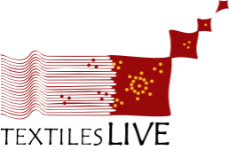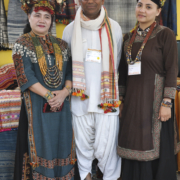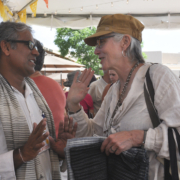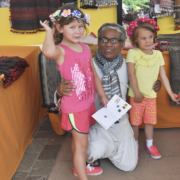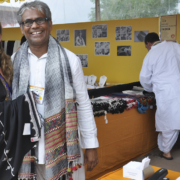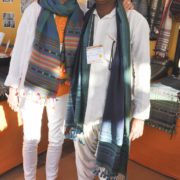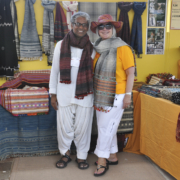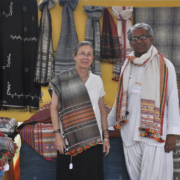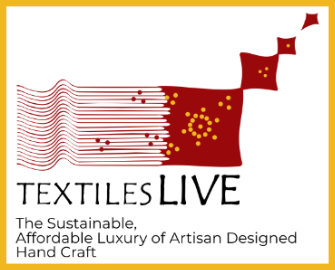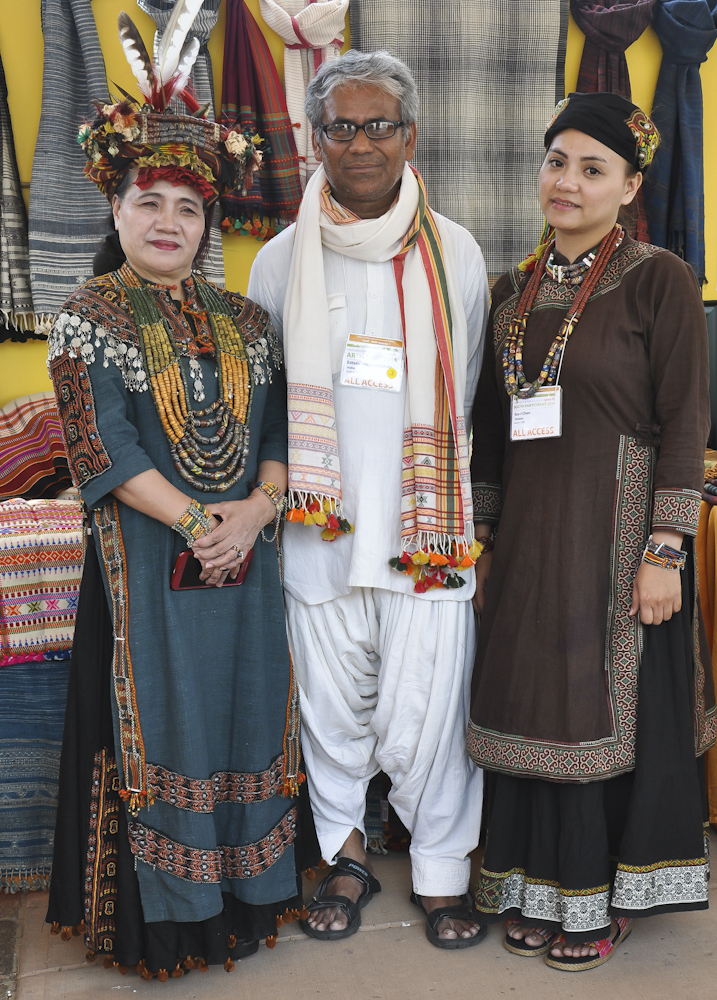 People were raving. “I’ve never seen anything like this before!” they exclaimed. “This weaving is amazing…fantastic…. gorgeous!” “Best in the show!” The accolades were pouring in. Curiously, there was in fact traditional weaving from Kutch in the “Best of the Best” booth just across the walkway. Dahyabhai and I could easily recognize it. The exciting thing was, the visitors were instead focusing on Dahyabhai’s innovation on the tradition. Wow! Design really works! Fortuitously, the Santa Fe actress Ali McGraw came into Dahyabhai’s booth early Saturday morning, and she was the first and most enthusiastic fan. She modeled Dahyabhai’s trademark rhythm checks for the next two days and directed customers to where they could get a stole too…. And that’s show biz.
People were raving. “I’ve never seen anything like this before!” they exclaimed. “This weaving is amazing…fantastic…. gorgeous!” “Best in the show!” The accolades were pouring in. Curiously, there was in fact traditional weaving from Kutch in the “Best of the Best” booth just across the walkway. Dahyabhai and I could easily recognize it. The exciting thing was, the visitors were instead focusing on Dahyabhai’s innovation on the tradition. Wow! Design really works! Fortuitously, the Santa Fe actress Ali McGraw came into Dahyabhai’s booth early Saturday morning, and she was the first and most enthusiastic fan. She modeled Dahyabhai’s trademark rhythm checks for the next two days and directed customers to where they could get a stole too…. And that’s show biz.
When the cotton checks sold out, people bought wool checks… until there was only a suitcasefull of miscellaneous non-checks left.
At the end of the two and a half whirlwind days of the Santa Fe Folk International Art Market, we sat quietly at my friend Robert’s table and tallied the sales. They were more than double what Dahyabhai averages in a year. We did some quick calculations. It is not all profit, of course. He had to extend his capacity beyond himself, his son and his wife. He had hired two weavers. And he had maxed his cash credit account to purchase raw materials. But he had benefited from the financial aid the Market provides some first time participants, and clearly, he was in the best financial situation of his life so far.
Dahyalal Kudecha is a traditional weaver from Kutch. His grandfather wove. His father gave up the tradition to work in a salt mine because it earned more money. When his father needed medical treatment, the family migrated to Bhujodi, a weaving village, and Dahyabhai experienced the environment of his traditional art. He decided to learn weaving, and for over 25 years he earned his livelihood through job work for a master weaver. But he always had two dreams: higher education for his sons, and to become an independent artist.
In 2008 Dahyabhai took Kala Raksha Vidhyalaya’s year-long design course, and learned to innovate within his tradition. He gained confidence in his creative capability, and began to take creative risks. He began his own business. A natural teacher, he joined KRV as a core faculty member in 2010, and today is a faculty member of Somaiya Kala Vidya.
Teaching, Dahyabhai honed a sophisticated understanding of design, and a deep love for his tradition, both of which he seamlessly weaves into his work. Design took Dahyabhai out of the village, to a fashion show in Mumbai, a collaboration with an Egyptian weaver in Delhi, an international conference of weavers in Cusco, Peru. He became known; but more important he gained exposure, which he could apply in design innovation.
Last September, Dahyabhai submitted his portfolio to the highly competitive Santa Fe International Folk Art Market, and was juried in. This brought him the experience of a lifetime- a trip to the USA to experience this magical market.
On the final leg of our 3-day journey home, I asked Dahyabhai his impressions.
The Market began with a two-day workshop for first time participants.
He felt that was important in preparing him for the Market. It was an opportunity to meet people- staff as well as artisans. The exercises helped to create a sense of community and comradery. “I learned how to overcome the language barrier,” he said. “I became confident. After that, everything seemed easy and ready to apply in the Market. Having Marilyn as a mentor was really great. The volunteers were also helpful.”
The Market itself showed him the limitlessness and value of craft. “It took me beyond my imagination,” he said. “I learned about artisans of the world, and customers of the USA. I learned what people like, what is marketable- colours, finishing, and the importance of tradition. People at the Market are attracted to our customs. I realized in a real way that we need to retain our identity. We need to present our culture.”
I asked what he would remember most from the Market? “People from all over the world!” he said. “But art and being artisans unified us all. Being an artisan made me feel part of a family.”
And what will he do on return? “Share what I learned with my colleagues!” Dahyabhai filled two data cards- totaling 12 MB- twice with images. He is planning a mega slide show presentation for all of the students of the Business and Management for Artisans course he is currently taking, and the Somaiya Kala Vidya staff. With his earnings, he plans to source new materials, try new experiments, and especially expand his capacity. “That will be win-win,” he grins, using a concept from the course. He can increase production so that next time he won’t run out of his best sellers, and he can give work and some training to less developed artisans. He is thinking how best to utilize and maintain the contacts he made at the Market, and how to get feedback that will help him in his work. “I’m also thinking of getting a computer,” he said. “A laptop will be useful in making presentations. And maybe I will build a website; people asked for that.”
Dahyabhai’s sons are both in college. The younger one weaves while studying business. He proudly shows a new, elegant design he wove while his father was away. The elder one, studying engineering, has been happy to find that he has a role to play in marketing. His daughter helps with finishing and is going to study tailoring and pattern making, and his wife weaves, a vanguard for women as full economic partners. Over that last six years, the family has begun to see a bright future for craft.
Would Dahyabhai have gotten into the Santa Fe Market if he had not studied design? Possibly. But I feel sure that the rave reviews he enjoyed were directly related to that extra edge his education gave him. And, I am confident that his design capability will transform his experience into a super next collection.
Tradition, design education, and the Santa Fe Folk Art Market: a win-win-win combo!
